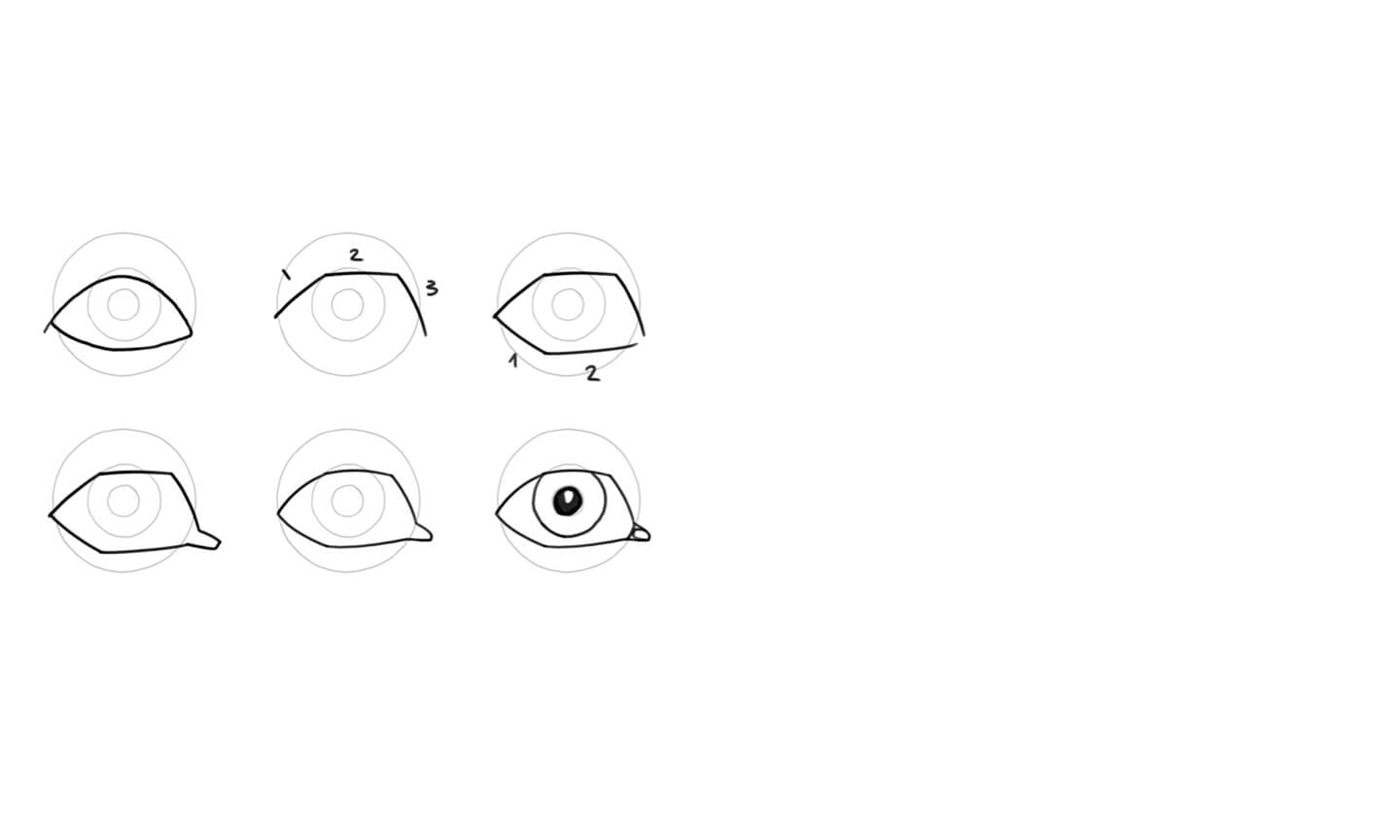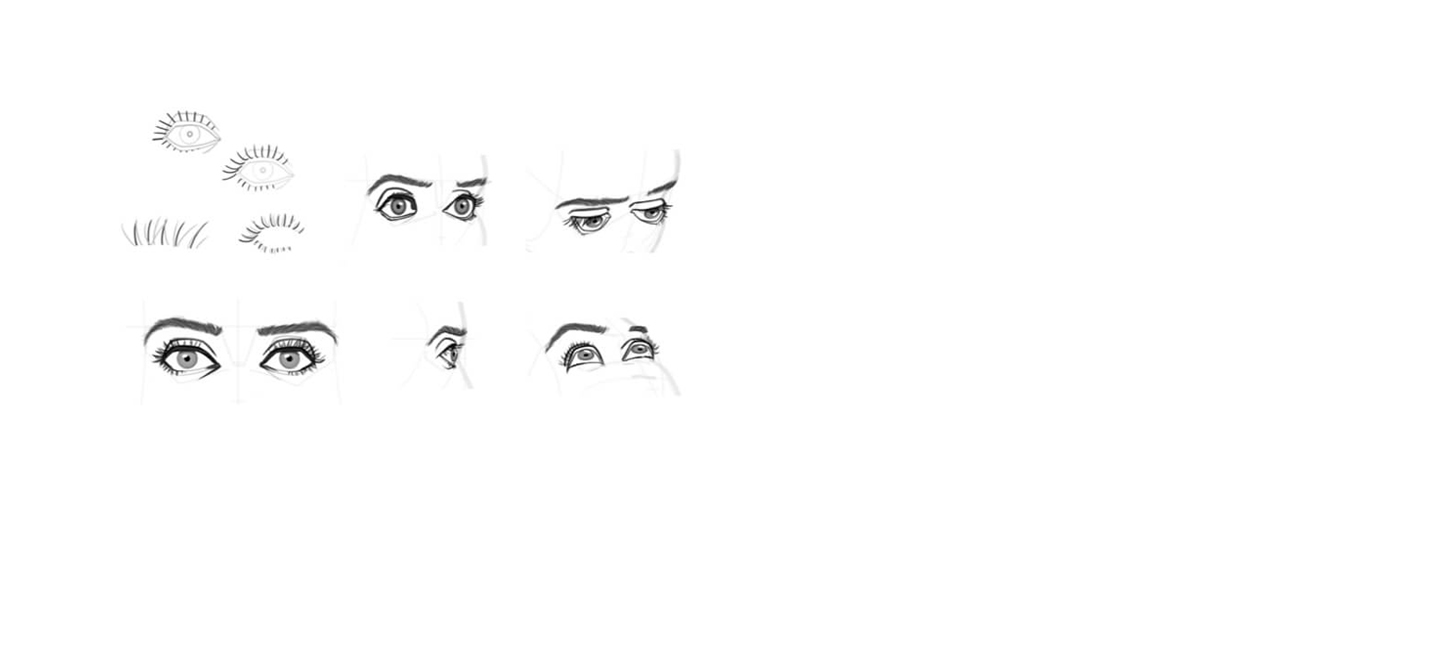


目の描き方についてご紹介します。描き方は一つではありませんが、どんな描き方でも使えるポイントやコツがあり、ここではそのような技術やスキルを磨くのに役立つヒントをご紹介し、楽しく学べるように解説します。

初めて顔を描くときに、2つの点や線で目を表現したことがあると思います。何度か描いていくうちに、円の中心に点を描いた目になったのではないでしょうか。この簡略化した表現は、実は目の本質をかなり的確に捉えています。目は2つの球体で、球体には視線を示す瞳孔があります。次のステップで、目で感情を表現することに挑戦します。目の基本となる円形の内側に上まぶたを追加します。まぶたを上げると「怒り」や「不機嫌」な印象を、まぶたを下げると「悲しみ」や「おとなしい」印象になります。
この基本的な目の表現方法はマンガ、アニメの定番です。このようなコミックタッチの目でも、様々な感情を十分に表現できます。一見単純な形で表現されているように見えますが、描き手が熟考を重ねたうえで、この目の形に行き着いたことが分かります。このことを念頭に入れて、次のステップに進みましょう。

まず、実際の目の構造を理解しましょう。どのイラストでも毎回、目の構造を如実に描く必要はありません。どの部分を強調し、どの部分を省略するかは、描き手が自由に決めることです。意識的に描き分けることで、各人のスタイルができあがっていきます。
ここでは目の構造に注目しましょう。
ご存じのように、目はピンポン玉サイズの球体で、顔面に収まっています。この球体を描くところから始めましょう。球体に横軸と縦軸を加えれば、これが単なる円ではなく3次元の球体であることがわかります。このイラストでは、やや左上を向いています。円をちょうど半分に分ける楕円になるように、縦と横の2つの軸を描きましょう。

正面から見たときの虹彩の大きさは、だいたい眼球の半分です。瞳の大きさには個人差があり、光の射し込み具合や表情によっても変わります。虹彩は眼球に平面的に乗っているわけではありません。コンタクトレンズのように少し膨らんでいます。正面から目を描くときには、このような細部を気にする必要はありませんが、目の向きを回転させると、この「膨らみ」が目立つようになります。瞳は厳密には黒い点ではなく、眼球に光を取り入れるための小さな穴です。瞳は虹彩の上ではなく、虹彩のレンズの奥に同心的に位置します。そのため、横向きの目を描くときには、瞳をやや中心寄りに動かします。
例は、それぞれに異なる3方向を向いた目です。虹彩と瞳の変化に注目してください。

次に、アーティストが描いている「目」とは、どのような形なのかを見ていきましょう。一般に「目」と呼ばれているのは、上まぶたと下まぶたに挟まれて、眼球の一部が姿を見せている部分のことです。基本的に、まぶたの縁は向かい合った2つの平たいU字のような形をしています。このU字型をもう少し詳しく見てみましょう。
上まぶたのラインをさっと描くことのできるベテランでも、上まぶたを描く前に頭のなかで少し構想を練っています。まぶたのラインがほんの少しずれるだけで、顔の表情がまったく変わってしまうからです。ここで、まぶたを3分割するのがコツです(難しいラインを複数に分けて描く方法は、まぶたに限らずどの下描きにも使えます)。下まぶたも分割できますが、
ストロークは3画ではなく2画にするとよいでしょう。上まぶたは3分割、下まぶたは2分割にして描くと、目の表情に活気が生まれます。逆に、上まぶたを2画、下まぶたを3画のストロークで描くアーティストもいます。試してみてください。
中央寄りの部分(この図では右側)には、涙点と呼ばれる部分があります。
この形は顔によって様々で、涙点がまったくない場合もあります。
これで目の形の下描きができました。次は、分割したラインの角を少し丸くします。あるいは、上下のまぶたをそれぞれ滑らかな線で一筆で描くこともできます。

この5本線の考え方は、色々な場面で応用できます。ラインの長さや角度の違いにより喜怒哀楽を表し、目を豊かに表現できます。下描きのラインを元に好きなスタイルで描き進められますが、デザインの手法の一つとして、この方法もぜひ試してみてください。

上下どちらのまぶたも、一定の厚みをもつことが大切です。厚みがあるため、横から見るとまぶたは眼球より少し突き出た感じになります。先ほどの5本の線とほぼ平行に、球体に沿ってまぶたの縁を描きます。泣き顔を描く場合は、下まぶたの狭い角の部分に涙がたまることを覚えておくと便利です。上下どちらのまぶたも常に見えているとは限りません。上から見ているか、下から見ているか、目がどのような動きをしているかによって変わります。

このように様々なアングルから目とまぶたを描くことができます。球体からスタートし、球体を覆うまぶたをイメージします。5本の線で基本的な形を作ります。見る角度に応じて5本の線の長さや角度を調整します。角度によっては2、3本の線だけで描いたり、横顔の場合などは、他の線が眼球の後ろに隠れて見えないこともあります。まぶたの狭い縁が見えてくる位置や、強調するラインと省略するラインについては、顔に目を描き込みながら詳しく見ていきましょう。

ここからは、様々な向きの頭を題材にして目を描いてみます。もしまだ見る角度によって頭の形を描き分けることが難しい場合は別のチュートリアル「人の頭の描き方」から学ぶことができます。今回は、このチュートリアルで描いた頭を使います。例のような頭を土台とすれば便利ですが、絶対に必要というわけではありません。
目の領域を決めるために、鼻の上方にある、ほぼ三角形の小さなエリアから始めましょう。例のように、この三角形は下向きの顔では短く、上向きの顔では長くなります横顔の場合、三角形は一つの直線になります。
なお、三角形を描くときに顔の中心線を補助線として参考にすると、位置を取りやすくなります。

次に、非常に重要なポイントですが、目の周りの骨の形を簡単に捉えたいと思います。顔面にパンチやサッカーボールが飛んできても、この骨が目を守ってくれます。目の周りの骨を定義するとき、最も簡単なのがヒーローのマスクを使う方法です。先ほどの三角形が出発点になります。
まぶたのラインと同様に、マスクも上3本、下2本のラインで構成されます。外側の端は、頭の側面の切り取り部分とぴったり一致します。頭を傾けた場合にマスクの角度がどうなるか、どのラインが短くなるかに注目してください。横顔では、もちろんマスクの一部しか見えません。

眼球は顔の表面に貼りついているわけではなく、頭部のかなり深いところに位置しています。そのため、この球体をマスクの中に配置するときは、少し引っ込めるようにします。どれだけ引っ込めるかは視点によって変わります。特に上向きの顔の場合は顕著に表現され、横顔の場合もよく分かります。正面向きだと、眼球の深さは少し見たでは分かりません。
2つの眼球をどのくらい離すかは、特に決まったルールはありません。よくわからない場合は、眼球の間にもう一つ分球体を入れるか、それよりもう少し広い幅を開けるとちょうどよくなります。

瞳と虹彩については、これまで学んだことが活きてきます。虹彩のわずかな膨らみを描くだけでも、目をより写実的に表現できます。正面向きの場合は不要ですが、他のアングルから横向きの目を描く場合、虹彩をカーブさせ瞳に深さをもたせることが大切です。

まぶたを描きます。まず左右の目頭に、顔のガイドラインから同じ距離になるように印を入れます。次に、目の原型となる五角形を描きます。きれいな球体が描けていれば、他の部分も自然に描けるでしょう。ここでも、頭の角度によって線の長さや角度を微妙に調整します。極端なアングルになると、線が内角に曲がることもあります。例の上向きと下向きの顔のような状態です。横顔では、虹彩が五角形の半分を占めます。

二重線でまぶたを縁取るときに、外側のラインを効果的に入れることで、視線の向きを強調できます。描いているアングルから、まぶたの縁のどの部分が見えるかに、細心の注意を払います。その部分は他よりも厚くなります。例えば上向きの顔の場合、上まぶたの縁しか見えませんが、顔を横に向けると、それ以外のまぶたの縁が見えてきます。

上まぶたと下まぶたのシワは、まぶたと顔との境目に入るラインです。上まぶたのシワは、目に奥行きを与えます。ここでは球体がガイドラインになります。まぶたを描いたときの分割線に沿って描いてもよいでしょう。老けた顔や疲れた顔にしたくない場合は、下まぶたのシワを上よりもやや薄く短くしたり、うっすらと線を入れとよいでしょう。

眉は、顔の感情をはっきりと表現しやすいパーツです。落ち着いた気分の真顔の眉は、三角形の上部から始まってやや上向きに伸び、徐々に細くなります。眉の端は、最初に頭の形をデザインしたときの切り取り面と一致します。
眉の形は輪郭から決めるとよいでしょう。これで、後の作業が簡単になります。眉の輪郭の内側に短い線を描いて、毛の生えている方向を表すこともできます。眉頭寄りは線を立てて描き、眉尻に近づくにつれて寝かせて描きます。

以上で準備は完了です。いよいよ創作の核心に入ります。ここからは、自分のスタイルを追求して描きましょう。描き手にはそれぞれ、独自のラインやタッチがあります。スケッチ風のスタイルが好みの人もいますし、すぐに肌の質感の描写や彩色に着手したい人もいるでしょう。もちろん、すべては描き手次第です。ここからはいくらでもイメージを膨らませることができます。しかし、今回のテーマは細かいスタイルの違いや彩色ではないので、すっきりとしたラインで目を仕上げていきましょう。
ご覧のように、まぶたの二重線を塗りつぶして、一つの太い線にしてもかまいません。特にまぶたの陰影の感じを出すには、太線が適しています。下まぶたの輪郭はやや控えめにするとよいでしょう。なぜなら光源が上にある場合、ここには基本的に影ができないからです。

ペンタブレットを使ったシンプルで効果的な描き方を紹介します。まず、虹彩を描くときは、ブラシの不透明度を30%ほどに下げます。虹彩よりも若干小さめのブラシを使うと簡単です。次に、虹彩に少し輝きを加えるため、ブラシサイズを小さくし、硬度を低くして、虹彩の中央にハイライトを描きます。瞳は黒く塗りつぶします。見る角度に合わせて瞳を虹彩の中心からずらすことも忘れずに。もう一度ハイライトを入れて、光の反射点を描き込みます。瞳から少しずらして描き込むとよいでしょう。必ずしも点である必要はなく、いろいろな形を試してみましょう。仕上げに、上まぶたの影を描きます。お好みで瞳から虹彩の縁に向かってかすかな線を白黒交互に描くと、虹彩の細部を表現できます。別のレイヤーで描き入れると良いでしょう。これは細部が見えるくらい大きい目を描くときだけにおすすめです。そうしないと描き込みすぎても、見えない場合があります。

少しの工夫で、のっぺりと塗りつぶされた眉をリアルに描くことができます。ここでは指先ツールやぼかしブラシを使います。このようなブラシは、必ず眉毛の向きと同じ方向にさっと流します。はっきりしていた直線が、軽くぼやけたラインになります。ギザギザがきっちりすぎたり、乱れすぎたりしないように気をつけましょう。納得のいく形になったら少し色の明度を上げ、細かい毛を描き足して眉を仕上げます。ここでも適度な乱れ加減になるように、細かいラインを描き込みましょう。できるだけ素早いストロークで眉毛1本1本を描きます。眉毛の生える方向を意識しつつ、こまめに向きを変えながら描くとよいでしょう。なだらかな曲線を描きながら先細りするラインにします。

まつげも手強いパーツで、練習や何度か試す必要があります。まつげはまぶたを縁取る二重線の外側のライン上に生えているのがポイントです。また、まつげは目尻に向かうほど長くなっています。下まつげは上まつげよりも短く、目頭に向かうにつれて細くなり、ほぼ見えなくなることがよくあります。まつげは、どれもしなやかな曲線を描きます。まつげの曲線の向きは、目の膨らみをどこから眺めているかにより変わってきます。目の中心に向かうほどカーブは緩くなり、目の両端ではまつ毛は反対方向にカーブします。説明ではわかりにくいかもしれませんが、この例を見るとわかりやすいかと思います。
まつげを描くときは、2つのステップに分けるとよいでしょう。最初のステップとして、10本ほどのまつげを描きます。すべてのまつげが適切な方向にカーブするように慎重に描きます。長さにも注意し、眉毛と同じように先が細くなるように描きます。次のステップでは、描いたまつげのすき間に「乱れまつげ」を描きます(ここではグレーで表しています)。長さや曲がる方向を少し変え、ところどころに数本のまつげが密集したところを作ります。
頭の向きが変わると、まつげの向きも変わります。少し考えないと空間の広がりが捉えられないかもしれませんが、慌てずに、どの向きにするか慎重に考えましょう。

なかなか難しいテーマでしたが、チュートリアルは以上です。この内容を今すぐマスターして、使いこなせるようになる必要はありませんが、練習を重ねるうちに、このチュートリアルには目を描くために必要なヒントがほぼ網羅されていることがわかってくると思います。一つでも二つでも、何かコツがきっと身につくはずです。
ぜひ、試してください。では、次回もまたお楽しみに!
最後にネタバレになりますが、次のチュートリアルの予告。今回せっかく描いた目も、場合によって鼻の後ろに隠れてしまうようなイラストを描きます。
Wacom One は13.3型ディスプレイで、紙にペンで描くような自然な描き味を持つ液晶ペンタブレット。軽量で手になじむペンが鉛筆、絵筆、チョークなどの様々な画材に早変わり。リアルな目も、これ一つですぐに描き始められます。ダウンロード可能なバンドルソフトウェア付き。MacやWindows以外にも、一部のAndroid端末で使用できます。

Wacom One 液晶ペンタブレット 13
デジタルイラスト制作や画像編集などのクリエイティブ用途に最適なデジタルスターターパックです。
ワコムではその企業理念として、人々がテクノロジーを自然に利用できるようなインタフェースを提供することで、人とテクノロジーの架け橋となることを追求しています。この理念のもとに、ワコムはインタラクティブに使用できるペンタブレットやペンディスプレイ、デジタルペン、電子サインの保存・処理ソリューションの分野を世界的にリードするメーカーとなっています。ワコムの直感的に使用できる入力デバイスの高度なテクノロジーは、今最も注目されるデジタルアート、映画、特殊効果、ファッション、デザインなどの制作において世界中で使われています。また、ビジネスからホームユースまでのさまざまなシーンでユーザーの個性を表現するための最先端インターフェース技術を提供しています。ワコムは1983年に日本で創業されて以来(東証1部:コード 6727)、世界的に事業を展開するメーカーとして成長してまいりました。現在、150ヶ国以上における製品の販売や流通を支えるために世界各地に子会社や関連会社を設けています。